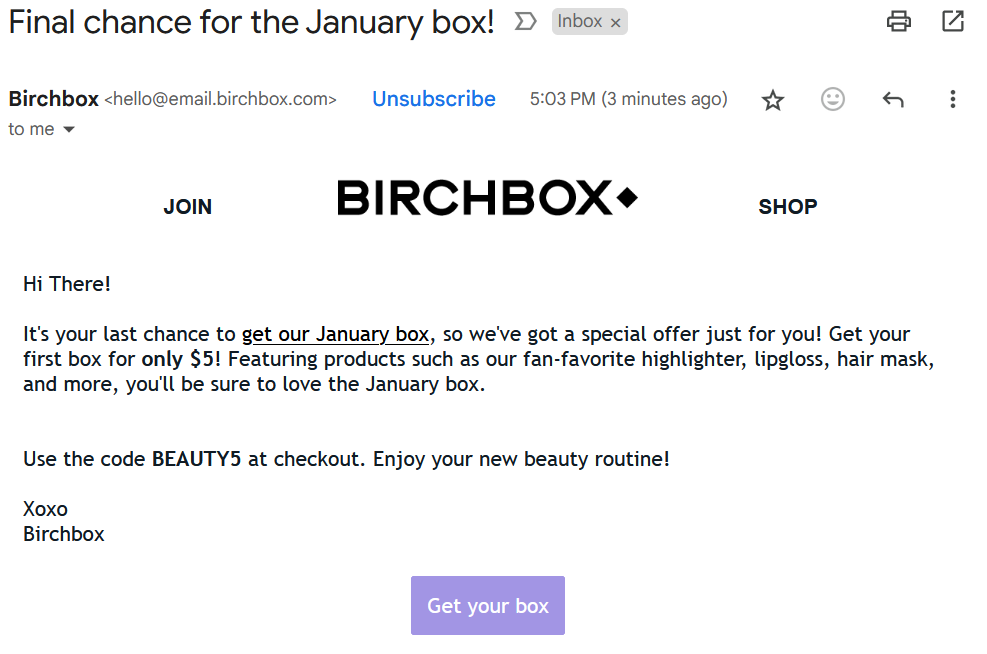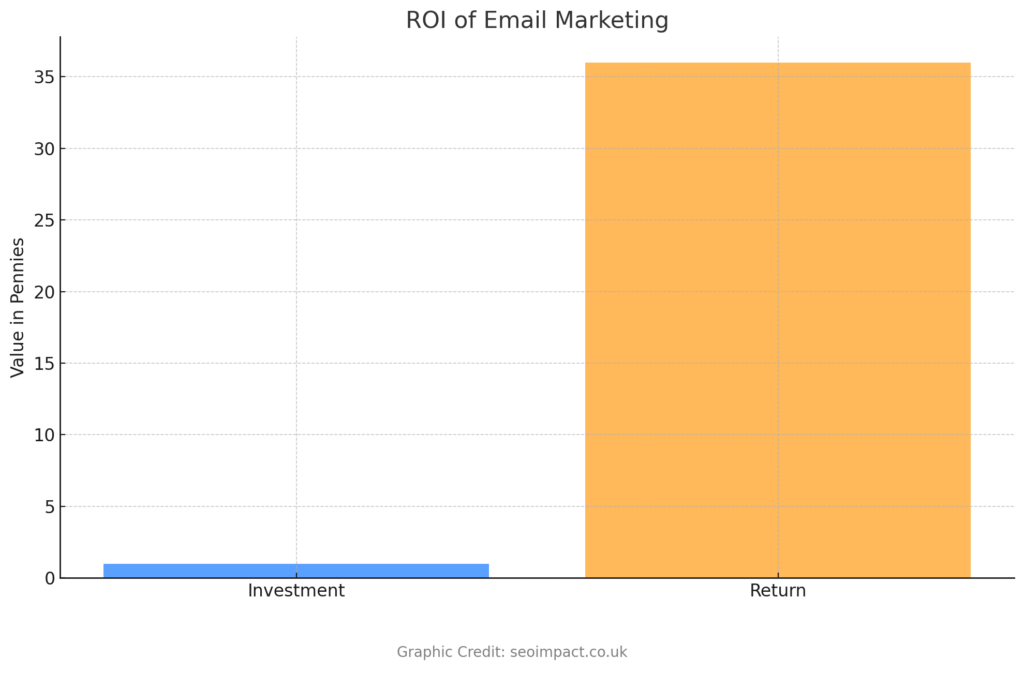Getting an email is the modern-day equivalent of getting a letter in the post. Sure, it arrives on your screen instead of through the letterbox on your front door, but it’s still a relatively personal means of communication. The email landed in your inbox. If the email marketing team is doing their job properly, then it’s probably got your name on it. Maybe it contains information or offers customised to your preferences and interests.
So, if you want to communicate directly with your customers, email marketing is a good place to start.
What is Email Marketing?
Email marketing is the practice of sending promotional material, newsletters, or offers, to a list of subscribed email accounts.
It’s a way of getting directly in front of your target audience, increasing brand awareness, and driving leads and conversions.
With this marketing strategy you can customise your material to specific users, creating more opportunities to engage potential or existing customers.
Here’s an example of some email marketing I found in my inbox this afternoon.

Is Email Marketing Heading Towards Extinction?
Email marketing is the oldest form of digital marketing. It’s been around since the advent of the internet, yet it remains one of the most effective forms of marketing. In terms of return on investment, it’s hard to beat it.
Research has shown that email marketing has a 1 to 36 ROI ratio, so for every penny spent, you can expect to bring in 36 pennies.

While marketing via social media channels is on the rise, email marketing certainly isn’t getting left out in the cold. Most people with email accounts check their inboxes several times a day, at least, so it’s a guaranteed way of getting seen by your potential customers.
Appearing in a user’s inbox is also quite personal, or even intimate, much more so than a user scrolling by an ad on Google or Instagram.
It can harness this opportunity and build a connection in a way that other less personal types of marketing cannot.
Email Marketing Starter List
New to email marketing? Use this beginner’s guide to get your strategy off the ground.
Create an Email List
Before you can start an email marketing campaign, you have to have some addresses to send your emails to. This means you need a database of email addresses, and you have to have the user’s permission to send them emails.
The easiest way to build an email database is by offering something to users that they want, in exchange for them using their email address to sign up to your database. You could offer ‘10% off for new customers’ on your website, and the code gets emailed to them once they sign up. Or maybe you’ve got a free e-book you can offer when customers sign up, or maybe a printable download.
Once you’ve built up a database, you can move on to starting an email campaign.
Make a Plan
Create a schedule for your email marketing strategy, and stick to it.
This could be one promotional email per week and an informative newsletter once a month, or maybe you’ll have an email automatically sent out each time a new blog post is published on your site. Research what type of email marketing is going to work best for your specific industry and business.
It can be beneficial to create a good balance so that customers don’t feel like they’re being continuously inundated with emails from you. Sticking to a schedule builds predictability and trust, which will work in your favour.
Establish Your Goals
Setting goals will help you determine the more practical parts of your plan, such as email frequency and email content. Are you trying to build traffic to your website?
In this case, informative emails and updates about what is going on at your site will be preferable. Aiming to increase immediate sales? Then a promotional email with a limited-time discount code can work well.
Creating Content For Email Marketing
You’ve got a bunch of email addresses, but what are you actually going to send to these users? Consider these tips to get you started.
What Do You Want To Say?
The content of your emails is often the deciding factor between an existing subscriber sticking with you or hitting the ‘unsubscribe’ button. When a user opens their email from you, they need to find that this action has added value to their life in some way.
Maybe your email has informed them about a sale, and just saved them money on a purchase they were going to make anyway.
Maybe you’ve let them know about an upcoming event they are interested in.
Whatever your content is, ensure it’s beneficial to the user in some way, and that you have something to say.
Sending emails just for the sake of it will get old, fast.
Keep it Short and Sweet
The content of your content isn’t all you have to think about.
Consider how the email is displayed. Most users will view emails on a mobile device, so a text-heavy email is going to be offputting.
Try to be concise so that the user can understand your message by quickly scanning it, and include visual elements to make it more appealing to look at.
If you have a lot of information you want to impart to the user, add a link to the email where they can be directed to read more.
Avoid Click Bait
Most people online these days can spot clickbait from a mile off.
If your email subject looks like clickbait, they probably aren’t even going to get as far as opening the email.
Be sure to use a subject line that is engaging or compelling, so that a user can’t resist the temptation to open the email. But don’t mislead or use clickbait, because although this might get you an immediate click-through, it will only harm your reputation and customer perception in the long run.
Use a Call to Action
There should be a call to action at the top and bottom of your email. This allows for users who only look at the first part of an email, as well as users who engage all the way to the bottom.
A call to action can encourage or remind a user to check out your product or services, and it gives them an easy and direct way of getting to your website without having to enter it into the search bar.
In a Nut Shell
Email marketing is a useful tool for fostering relationships with your customers, and keeping them in the loop with everything that’s going on with your brand. Ultimately, it can significantly boost traffic to your website and lead to an increase in conversions.
Despite the availability of other digital marketing channels, email marketing remains popular amongst the majority of marketing professionals, because put simply: it works.
Need help formulating an email marketing strategy? Reach out to us today.
- Canonicalization: The Dos and Don’ts of Canonical Tags - May 27, 2024
- On-Page SEO: The Ultimate Guide - May 25, 2024
- The Only WooCommerce SEO Tutorial You Need in 2024 - May 23, 2024